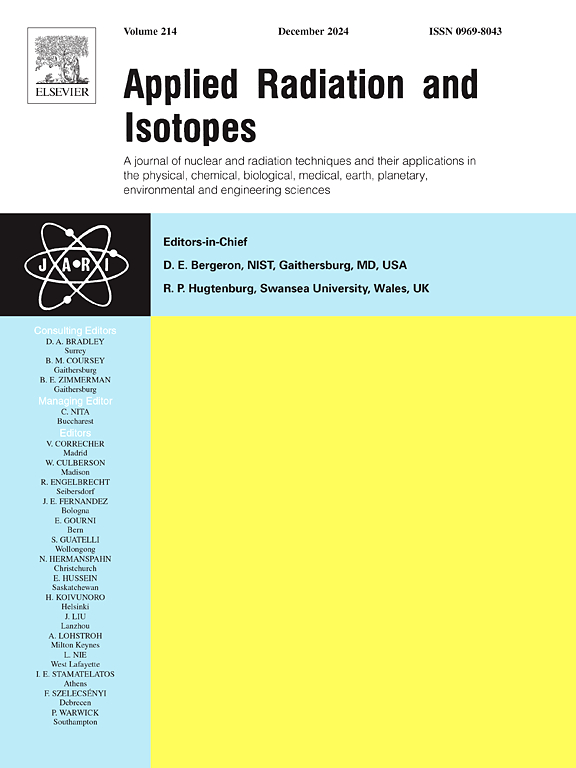Measurements of the high dose rate brachytherapy 192Ir source reference air kerma rate: a retrospective analysis of the single institution results
IF 1.8
3区 工程技术
Q3 CHEMISTRY, INORGANIC & NUCLEAR
引用次数: 0
Abstract
This work reports on the experiences and results of a single radiotherapy centre in over twenty years of well-type ionisation chamber reference air kerma rate (RAKR) measurements of two models 192Ir high dose rate brachytherapy (HDRBT) sources. Quality assurance (QA) programmes worldwide recommend determining the RAKR of sources before being used in patient treatment. The observed discrepancies between the measured RAKR and the manufacturer's stated RAKR were analysed. A systematic analysis of the data was used to calculate the uncertainty budget. Measurement procedures and conditions were adjusted during the time to warrant accurate and consistent results. The RAKR uncertainty budget was estimated by examining all contributions to the model equation for calculating RAKR from measured signals. The mean percentage difference between the measured RAKR and the manufacturer's certificate value of 0.32 % ± 0.97 % was obtained. An analysis of these differences revealed a potential drift in chamber sensitivity over time and a shift in results following the introduction of a new chamber. Nevertheless, all observed differences were within the 3 % tolerance level and 85 % within the 1.5 % level. The overall expanded uncertainty of the measured RAKR of the HDRBT 192Ir source of 3.04 % (k = 2) was estimated. Independent determination of RAKR of an HDRBT source is crucial for accurate and reliable brachytherapy treatments. A detailed analysis of the uncertainties associated with RAKR measurements is indispensable for an appropriate understanding of the sources of uncertainty, means of their reduction, and any adjustments needed for clinical QA programmes.
高剂量率近距离放疗192Ir源参考空气kerma率的测量:单个机构结果的回顾性分析
本工作报告了单个放射治疗中心在20多年中对两种型号192Ir高剂量率近距离放射治疗(HDRBT)源进行井型电离室参考空气克氏率(RAKR)测量的经验和结果。世界各地的质量保证(QA)规划建议在用于患者治疗之前确定来源的RAKR。观察到的差异之间的测量RAKR和制造商的声明RAKR进行了分析。通过对数据的系统分析,计算了不确定性预算。测量程序和条件在此期间进行了调整,以保证准确和一致的结果。RAKR不确定性预算是通过检查从测量信号计算RAKR的模型方程的所有贡献来估计的。测量的RAKR与制造商证书值之间的平均百分比差为0.32%±0.97%。对这些差异的分析揭示了室灵敏度随时间的潜在漂移和引入新室后结果的变化。然而,所有观察到的差异都在3%的耐受性水平内,85%的差异在1.5%的耐受性水平内。HDRBT 192Ir源的测量RAKR的总体扩展不确定度估计为3.04% (k = 2)。独立测定HDRBT源的RAKR对于准确可靠的近距离治疗至关重要。对与RAKR测量相关的不确定度的详细分析对于适当理解不确定度的来源、减少不确定度的方法以及临床QA计划所需的任何调整是必不可少的。
本文章由计算机程序翻译,如有差异,请以英文原文为准。
求助全文
约1分钟内获得全文
求助全文
来源期刊

Applied Radiation and Isotopes
工程技术-核科学技术
CiteScore
3.00
自引率
12.50%
发文量
406
审稿时长
13.5 months
期刊介绍:
Applied Radiation and Isotopes provides a high quality medium for the publication of substantial, original and scientific and technological papers on the development and peaceful application of nuclear, radiation and radionuclide techniques in chemistry, physics, biochemistry, biology, medicine, security, engineering and in the earth, planetary and environmental sciences, all including dosimetry. Nuclear techniques are defined in the broadest sense and both experimental and theoretical papers are welcome. They include the development and use of α- and β-particles, X-rays and γ-rays, neutrons and other nuclear particles and radiations from all sources, including radionuclides, synchrotron sources, cyclotrons and reactors and from the natural environment.
The journal aims to publish papers with significance to an international audience, containing substantial novelty and scientific impact. The Editors reserve the rights to reject, with or without external review, papers that do not meet these criteria.
Papers dealing with radiation processing, i.e., where radiation is used to bring about a biological, chemical or physical change in a material, should be directed to our sister journal Radiation Physics and Chemistry.
 求助内容:
求助内容: 应助结果提醒方式:
应助结果提醒方式:


